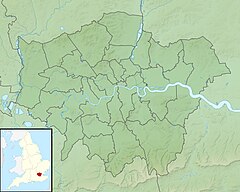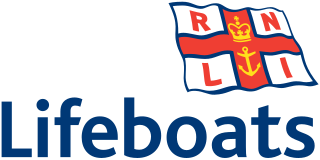
The Royal National Lifeboat Institution (RNLI) is the largest of the lifeboat services operating around the coasts of the United Kingdom, the Republic of Ireland, the Channel Islands, and the Isle of Man, as well as on some inland waterways.

The E-class lifeboat forms part of the RNLI fleet in the United Kingdom, operating exclusively in the tidal reach of the River Thames in London. The class was introduced in 2002 to serve the tidal reach of the River Thames, which had not previously been covered by an RNLI rescue service, as a result of a much delayed enquiry into the Marchioness disaster in 1989, in which 51 people died. The enquiry criticised the lack of a rescue service for the tidal Thames, and the UK government asked the Maritime and Coastguard Agency, the Port of London Authority and the RNLI to work together to set up a dedicated Search and Rescue service for this stretch of the river.
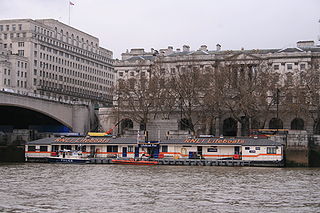
The Tower Lifeboat Station is a lifeboat station on the River Thames in London, UK, operated by the Royal National Lifeboat Institution (RNLI). It is located at Victoria Embankment on the North Bank of the Thames, next to Waterloo Bridge.
Blyth Lifeboat Station is operated by the Royal National Lifeboat Institution and currently operates a D-class (IB1) Sally Forth (D-878) and a B-class lifeboat Patricia Southall (B-923)
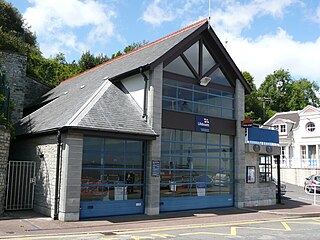
Penarth Lifeboat Station is located in Penarth, Vale of Glamorgan, Wales and originally opened in 1861.
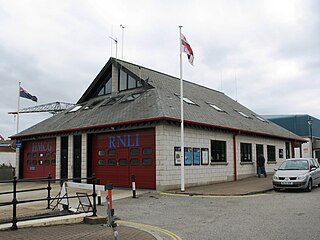
Falmouth Lifeboat Station is the base for Royal National Lifeboat Institution (RNLI) search and rescue operations at Falmouth, Cornwall in the United Kingdom. The first lifeboat was stationed in the town in 1867 and the present station was opened in 1993. It operates a Severn Class all-weather Lifeboat (ALB) and an Atlantic 85 inshore lifeboat (ILB).

The Waveney-class lifeboat was the first class of lifeboats operated by the Royal National Lifeboat Institution (RNLI) capable of operating at speeds in excess of 10 knots (12 mph). Based on an American design, 22 saw operational service between 1964 and 1999 at the RNLI's stations around the coast of the United Kingdom and Ireland. After being superseded by faster boats in the 1990s, many were sold for further use with lifeboat services abroad, notably in Australia and New Zealand.

Aldeburgh Lifeboat Station is an RNLI station located in the town of Aldeburgh in the English county of Suffolk.
Sheerness Lifeboat Station is an Royal National Lifeboat Institution (RNLI) station located in the town of Sheerness on the Isle of Sheppey in the English county of Kent. The station is on the north coast of the county, strategically placed at Garrison Point at the mouth of the River Medway and close the busy Thames estuary. The RNLI first stationed a lifeboat here in 1969.

Littlehampton Lifeboat Station is a Royal National Lifeboat Institution (RNLI) station in the town of Littlehampton, in West Sussex, on the south coast of England. The station is on the harbour side on the eastern bank of the River Arun, a quarter mile from the harbour entrance and the pier. The current lifeboat house on Fisherman's Quay was built in 2002. The lifeboat station currently operates with two inshore lifeboats: a B-class lifeboat, Renee Sherman (B-891) and a D-class (IB1) lifeboat, Ray of Hope (D-769).

Shoreham Harbour Lifeboat Station is a Royal National Lifeboat Institution (RNLI) station located in the town of Shoreham-by-Sea in the English county of West Sussex. It underwent extensive re-development in 2010 with a new purpose built boathall to accommodate its new Tamar-class all-weather lifeboat (AWB). It operates two lifeboats, the Tamar-class Enid Collett and the D-class (IB1) Inshore lifeboat Joan Woodland (D-784).

Happisburgh Lifeboat Station is a Royal National Lifeboat Institution (RNLI) Inshore lifeboat station close to the village of Happisburgh in the English county of Norfolk in the United Kingdom. Since 2003 the station boathouse has been re-located from the village to an area south called Cart Gap. This is because the beach below Happisburgh disappeared due to coastal erosion and the stations slipway and access was washed away. The original boathouse in the village is now used for training.

Eastbourne Lifeboat Station is a Royal National Lifeboat Institution (RNLI) lifeboat station in the town of Eastbourne in East Sussex. Founded two years before the RNLI was established, the station has operated continuously since 1822 and its lifeboats have been responsible for saving over 700 lives. There are two active lifeboat stations in Eastbourne, an all-weather station with the Trent-class 14-02 Esme Anderson at Sovereign Harbour and the D-class (IB1) The David H (D-876) at the inshore lifeboat station a couple of miles to the west at Fisherman's Green. An older lifeboat station, west of Eastbourne Pier, is now used as an RNLI museum.

Calshot Lifeboat Station is located on Calshot Spit near the village of Calshot, Hampshire, and is on the southern bank of the open end of Southampton Water, on the south coast of England. The station is owned and operated by the Royal National Lifeboat Institution (RNLI) and operates two inshore lifeboats: an B-class and a D-class (IB1).

Brighton Lifeboat Station is a Royal National Lifeboat Institution (RNLI) station located in Brighton in the English county of East Sussex in the United Kingdom. It was originally established in 1825 as an all-weather lifeboat station. This lifeboat was withdrawn in 1931, and the station now operates as an inshore lifeboat station. As of 2012, the current lifeboat is the B-class Random Harvest (B-852).

Clogherhead Lifeboat Station is situated in Clogherhead, Co Louth, Ireland and has been in operation since 1899

Plymouth Lifeboat Station is the base for Royal National Lifeboat Institution (RNLI) search and rescue operations at Plymouth in England. The first lifeboat was stationed in the city in the early 1800s. The station moved to its present site at Millbay Docks in 1992, a Grade II-listed three-storey tower. Since 2003 it has operated a Severn-class all-weather boat (ALB) along with an B-class Atlantic inshore lifeboat (ILB).

Anstruther Lifeboat Station is a Royal National Lifeboat Institution (RNLI) station located in the town of Anstruther, Fife. The station has been in operation since 1865, although RNLI activity in the area dates back to 1832. The station houses the all-weather Mersey-class lifeboat 12-17 Kingdom of Fife and inshore D-class lifeboat Akira (D-802)

Chiswick Lifeboat Station is a lifeboat station on the north bank of the River Thames at Corney Reach, Chiswick, in west London. It is one of the newest stations operated by the Royal National Lifeboat Institution (RNLI), and one of the first to cover a river rather than estuarial waters or the sea.

Gravesend Lifeboat Station is situated on the Royal Terrace Pier in Gravesend, Kent, on the lower reaches of the River Thames. It is one of the newest lifeboat stations operated by the Royal National Lifeboat Institution (RNLI), and one of the first to cover a river rather than the sea or estuarial waters.




